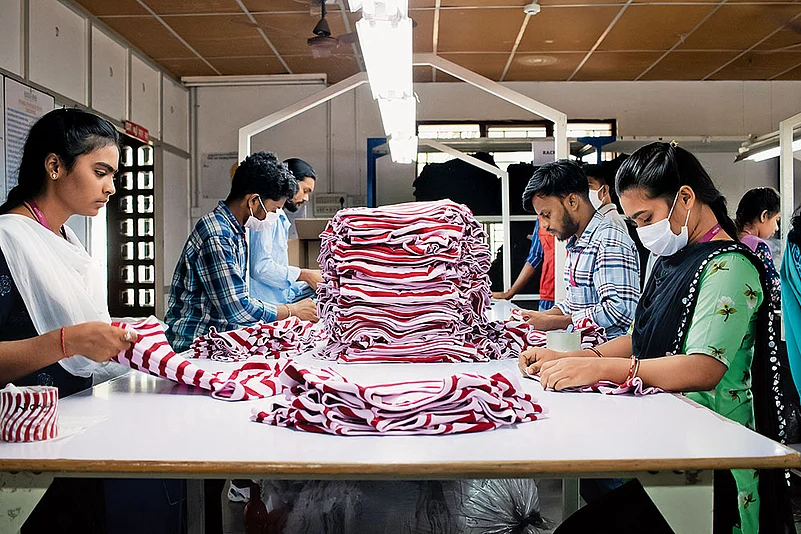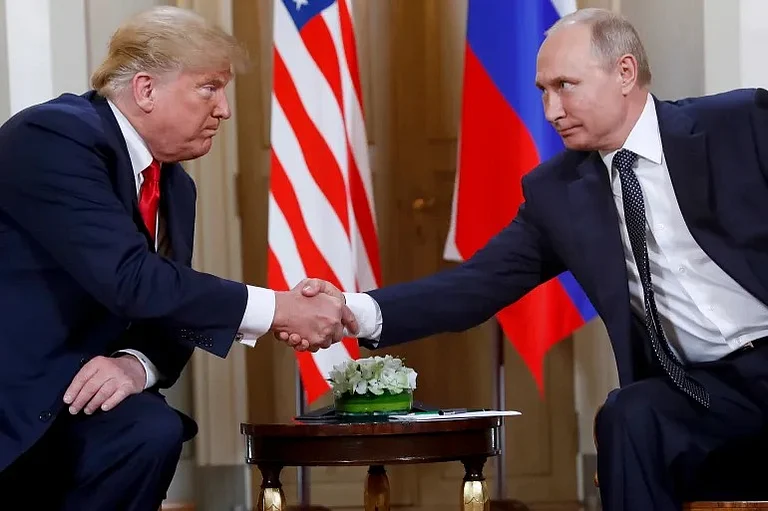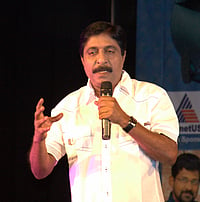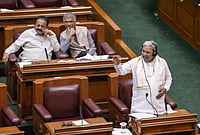
Tiruppur and Coimbatore, India’s textile hubs employing over a million workers, face a severe blow as the US imposes tariffs of up to 50 per cent on Indian textile exports, threatening their $45,000 crore industry.
Exporters warn that while FTAs with the UK, EU, and TEPA nations may offer some relief, these markets are far smaller than the US, which alone buys $10 billion worth of Indian textiles annually.
MSME-driven units, especially in Tiruppur where 95 per cent of exporters fall in this category, risk closure and job losses—prompting urgent calls for government support and diversification of markets.
Like thousands of other women workers who throng the streets of Tiruppur, India’s ‘knitwear capital’ in the Tamil Nadu district of the same name, in the early hours every morning, 35-year-old Vimala hurries to reach her factory on time. Her workplace is in Poolavanpatti, a village on the city’s outskirts marked by narrow lanes and open drains. Nearly 300 women work in various departments of the textile processing company that has hired Vimala. While she has been in the ironing section for the past few months, many of her co-workers are engaged in stitching, knitting and fabric processing. They are among Tiruppur’s workforce of over a million, nearly 65 per cent of them women. Their lives are shaped instead by the rhythm of factory shifts, long commutes and the hope that steady work will secure a modest future.
Until the late 1970s, however, this bustling industrial hub was a quiet agricultural town. The transformation began with the rise of small-scale textile units, which gained momentum after economic liberalisation opened the doors for global textile buyers. Today, Tiruppur’s prosperity rests on the fortunes of thousands of export-driven units, which are vulnerable to the uncertainties of international trade. No wonder the recent turbulence in global trade—particularly the tariff imposition by the United States—has cast a shadow over cities like Tiruppur that thrive or sink depending on the ebb and flow of international demand.
Industrialist and exporter Thirukumaran has weathered many such storms in the past 35 years. The COVID-19 pandemic and the global disruptions triggered by the Ukraine war were among the latest challenges he navigated. Yet, 2024-25 seemed to signal a turning point. Considering that trade agreements with several countries were in the pipeline, he—like many other textile exporters—was brimming with confidence. The previous fiscal had brought a measure of stability and growth, while talk of a favourable trade agreement with the US and the signing of a Free Trade Agreement (FTA) with the United Kingdom only added to the optimism.
That optimism was abruptly shaken when US president Donald Trump announced a 25 per cent tariff on Indian products, followed by an even more alarming declaration that it would rise to 50 per cent. The news dealt a heavy blow to the exporters’ expectations. While they do hope to navigate the turbulence, the uncertainty hanging over the industry is unmistakable.
“While 25 per cent will make us uncompetitive, a 50 per cent tariff will make it practically impossible for us to do business,” says Coimbatore-based industrialist Ravi Sam, a former chairman of the Confederation of Indian Industries (CII), Tamil Nadu. “We are still hoping, though, for a negotiated trade deal with the US, which is actually targeting the BRICS countries (Brazil, Russia, India, China, South Africa, Egypt, Ethiopia, Indonesia, Iran and the United Arab Emirates). The US has, in fact, targeted all BRICS countries except China. I still think the issue can be resolved through talks. Many of our textile export industries are tuned to the requirements of the US markets, where 70 per cent of the bedsheets exported from India go as well as 50 per cent of the bath towels imported by the US. Once the US finds new markets, then it would be very difficult to bring them back. Having said that, the tariff would affect the US economy as well. In the short term, at least, they will have to face inflation and accompanying problems.”
The textile industry in Tiruppur and Coimbatore employs more than a million workers, and exports garments and other textile items worth more than Rs 45,000 crore annually.
India’s competitive edge—driven by lower raw material costs and robust domestic production capacity—has made it one of the world’s top textile exporters, ranking just behind China and the European Union in global share. In 2023-24, the US, the European Union and the UK together absorbed about 53 per cent of India’s total textile and apparel exports. The US remains the single largest market, importing goods worth $10 billion from India last year—roughly one in every four dollars earned by the sector in foreign trade. And Tamil Nadu contributes significantly to this.
The textile industry in Tiruppur and Coimbatore collectively employs more than a million workers, and exports garments and other textile items worth more than Rs 45,000 crore annually. In 2024-25, India’s total textile exports were worth $36.61 billion, out of which 26.68 per cent, amounting to $7.99 billion were from Tamil Nadu, making it the top textile exporting state in the country. According to industrialists, the rise in textile exports from the state mainly stems from the thriving industries in the Tiruppur cluster, which has manufacturing units for all textile-related activities. Therefore, any fluctuations in the export sector have uneven effects in Tamil Nadu. According to the Tiruppur Exporters’ Association, there are more than 2,500 textile export units in and around the city.
The exporters have already started feeling the heat of the tariff announced by the Trump administration, says N. Thirukkumaran, chairman of Estee Exports India (Pvt) Ltd and general secretary of the Tiruppur Exporters’ Association. “Though no buyers so far have cancelled orders, many have begun to hold back. Some units in the country are fully exposed to the US market, relying entirely on American orders. If the US persists with the tariff, it will spell trouble for them. The recently signed FTA with the UK and the possibility of a trade agreement with the EU could offset some of the damage, but that relief will take time. The UK market is far smaller than the US, and any deal with the EU would still need ratification by all member states. So, if the US persists with the tariff, it will disrupt the industry,” he adds.
The next round of India-EU trade talks will be held in the first week of September. According to the Commerce Ministry, the two sides have agreed on many chapters in the negotiations for what could be India’s largest trade agreement. Following the US announcement of tariffs, exporters have urged the government to expedite trade talks and reach an agreement as soon as possible.
Some exporters believe the uncertainty regarding the tariffs is creating the problem. “Once the US fixes its tariffs for different countries, then the exporters would chalk out plans to tide over the crisis,” says Sabu M. Jacob, managing director of the Kochi-based Kitex Garments. “I don’t think the US will impose the 50 per cent tariff, because it will affect their domestic market, too. It is very difficult for them to find an alternative market in a short time. Textiles being a labour-intensive industry, you need to get human resources and train them, and it takes time. So, at least the short-term repercussions will be there for the US market as well. Apart from the UK and the EU, the agreement with the TEPA countries (Switzerland, Norway, Iceland and Liechtenstein) will also help Indian textile exporters to somewhat offset the damage done by the US tariffs. The short-term effect will be transitory. In fact, I am moving ahead with a future investment plan in Telangana.”
The confidence is shared by Champalal Bothra, chairman of the Confederation of All India Traders (CAIT) in Surat, the diamond-polishing city that also powers India’s man-made textile engine as the country’s second-largest textile manufacturing hub after Tiruppur. The city boasts an estimated annual textile turnover of Rs 80,000 crore and provides livelihoods to nearly two million. According to the CAIT, Surat accounts for 40 per cent of India’s man-made fabric output and meets about 90 per cent of the country’s synthetic cloth demand. Synthetic fibre is one of Surat’s key exports, with around 18 per cent of its production headed for the US.
“The current order cycle is on hold as importers in the US and exporters in Surat have yet to agree on the prices,” says Bothra. “Future orders are also in trouble as both sides are unable to stand on the same ground. The US has become an increasingly important buyer for Surat in recent years, partly because brands have been shifting their sourcing away from China and Bangladesh.”
Disruption, however, is not new to the city’s traders. The 2021 coal price crisis in India had hit the textile processing units in Surat hard, with nearly 400 units cutting down production as coal prices were on the rise. A year later, the Russia-Ukraine war led to the closure of at least 15 textile dyeing and printing mills, which were unable to survive the high costs and shortages of both lignite coal and imported coal. Then, in 2023, the industry was still struggling to shake off the post-Covid slump, which had cut production by 30-40 per cent. A year later, political unrest in Bangladesh froze new orders and triggered payment anxieties. Bangladesh is a key buyer of Surat’s yarn and textiles, with monthly sales worth over Rs 100 crore.
Bothra says that FTAs with more countries and regions can help Surat’s textile industrialists find new customers. “We can take on the US tariffs by exploring alternative markets and customers. If 35 per cent of our exports currently going to the US are blocked, we can compensate by leveraging FTAs, amending policies and reducing costs,” he adds.
The majority of India’s textile-exporting units fall under the micro, small and medium enterprises (MSME) category—the backbone of the industry. In Tiruppur, for instance, 95 per cent of export units are MSMEs. Kumar Duraiswamy, CEO of Eastern Global Clothing, says the US tariff will sharply compound the challenges facing MSMEs. “If the current uncertainty is not resolved within two weeks, companies exposed to the US market will suffer significant losses. The government must announce a loan moratorium and credit ratings should not be downgraded in the near future,” he adds.
Finding an alternative to the US market, according to Duraiswamy, could take two years of sustained effort from exporters. Without support during this period, thousands of jobs—many held by women—will be lost, dragging down economic growth. If the current impasse is not addressed, industry experts warn that India’s ambition of reaching $100 billion in textile exports in five years could be at risk. While remaining cautiously optimistic that the US will ease tariffs on India, largely due to domestic pressure, they stress the urgency of diversifying markets, given the unpredictability of the Trump administration’s trade policies. That means the government must step up—offering targeted support to MSMEs and accelerating trade talks with other countries and economic blocs. If that happens, exporters hope the current crisis might, at least in the long run, pave the way for new opportunities.
(With inputs from Jinit Parmar in Surat)
MORE FROM THIS ISSUE
N.K. Bhoopesh is Assistant Editor, Outlook. He is based out of Kochi, Kerala





































